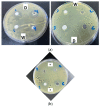Impact of Nanolayered Material and Nanohybrid Modifications on Their Potential Antibacterial Activity
- PMID: 36014614
- PMCID: PMC9416148
- DOI: 10.3390/nano12162749
Impact of Nanolayered Material and Nanohybrid Modifications on Their Potential Antibacterial Activity
Abstract
Due to an escalating increase in multiple antibiotic resistance among bacteria, novel nanomaterials with antimicrobial properties are being developed to prevent infectious diseases caused by bacteria that are common in wastewater and the environment. A series of nanolayered structures and nanohybrids were prepared and modified by several methods including an ultrasonic technique, intercalation reactions of fatty acids, and carbon nanotubes, in addition to creating new phases based on zinc and aluminum. The nanomaterials prepared were used against a group of microorganisms, including E. coli, S. aureus, Klebsiella pneumoniae and Pseudomonas aeruginosa. Experimental results revealed that a nanohybrid based on carbon nanotubes and fatty acids showed significant antimicrobial activity against E. coli, and can be implemented in wastewater treatment. Similar behavior was observed for a nanolayered structure which was prepared using ultrasonic waves. For the other microorganisms, a nanolayered structure combined with carbon nanotubes showed a significant and clear inhibitory effect on S. aureus, Klebsiella pneumoniae and Pseudomonas aeruginosa. It is concluded that the nanolayered structures and nanohybrids, which can be modified at low cost with high productivity, using simple operations and straightforward to use equipment, can be considered good candidates for preventing infectious disease and inhibiting the spread of bacteria, especially those that are commonly found in wastewater and the environment.
Keywords: Zn/Al nanolayered; antimicrobial resistance; layered double hydroxide (LDH); modified nanohybrids; nanotubes and fatty acids; ultrasonic.
Conflict of interest statement
The authors declare no conflict of interest.
Figures








References
-
- Vahabi K., Mansoori G., Karimi S. Biosynthesis of Silver Nanoparticles by Fungus Trichoderma Reesei (A Route for Large-Scale Production of AgNPs) Insci. J. 2011;1:65–79. doi: 10.5640/insc.010165. - DOI
-
- Lu H., Wang J., Stoller M., Wang T., Bao Y., Hao H. An overview of nanomaterials for water and wastewater treatment. Adv. Mater. Sci. Eng. 2016;2016:4964828. doi: 10.1155/2016/4964828. - DOI
-
- Saber O., Shaalan N.M., Ahmed F., Kumar S., Alshoaibi A. One-Step Multi-Doping Process for Producing Effective Zinc Oxide Nanofibers to Remove Industrial Pollutants Using Sunlight. Crystals. 2021;11:1268. doi: 10.3390/cryst11101268. - DOI
Grants and funding
LinkOut - more resources
Full Text Sources

